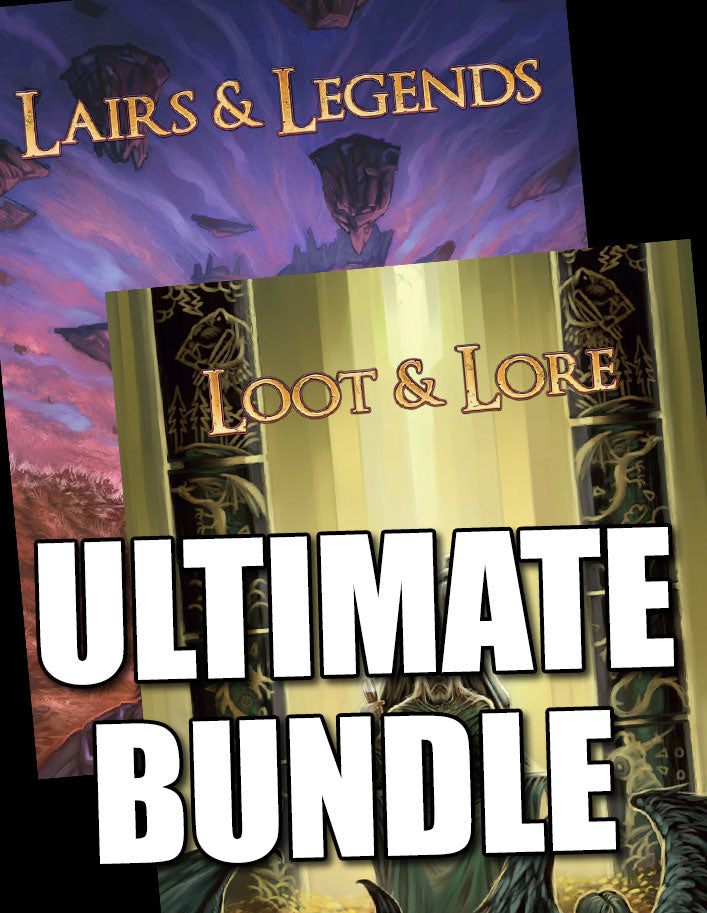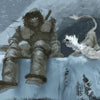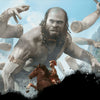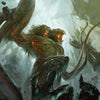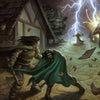10 Tips for Using Theater of the Mind in D&D
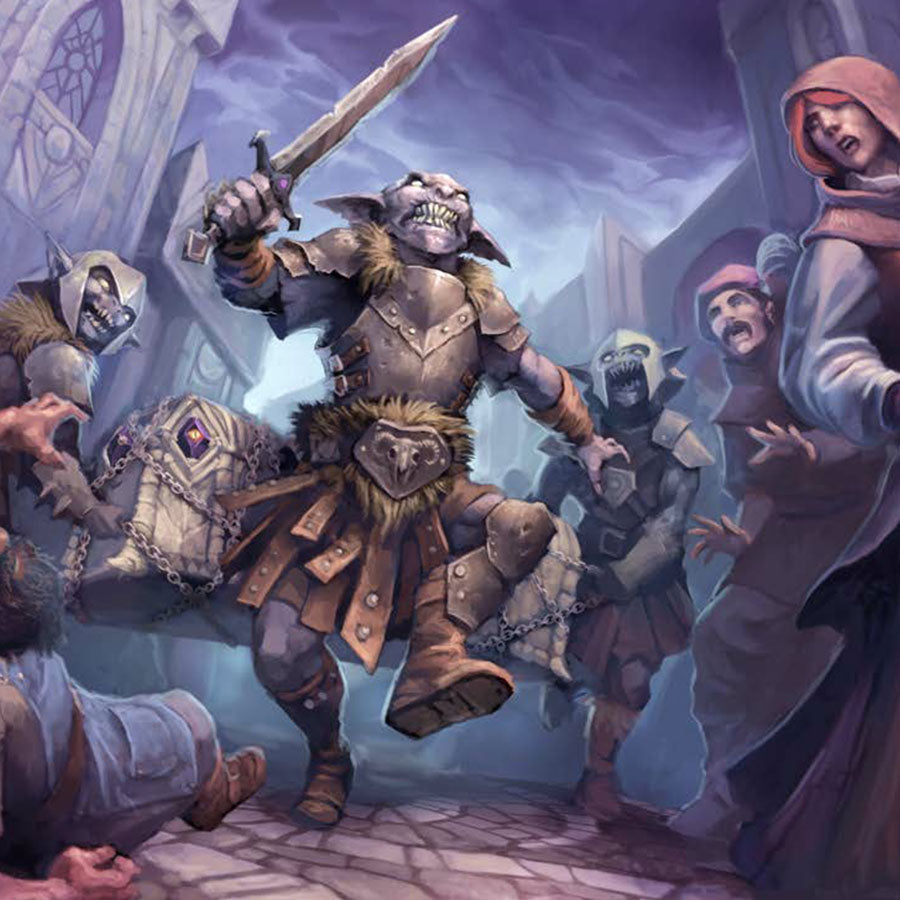
Today we’ll be discussing ten tips for using Theater of the Mind (TotM) in Dungeons & Dragons. In case you’re not familiar with that term, theater of the mind is what we call it when you and the players are NOT using physical representations of the PCs and enemies on a combat map – such as having miniatures on a grid – and are instead keeping track of the combat and everything else in your minds.
By the way, if you’re a new dungeon master feeling a bit OVERWHELMED by everything involved in running a D&D game, I completely understand. Being a DM isn’t always a walk in the park, and my personal goal is to help game masters by providing information and resources to make your life easier! Lairs & Legends is one such resource. With over 700 pages of adventures, monsters, puzzles, traps, and other GM resources, you can SIGNIFICANTLY reduce your prep time and still run amazing games for your players.
Watch or listen to this article by clicking the video below.
1. Stop Counting Feet!
This my way of saying that with TOTM you should STOP using specifics – and especially don’t try to express distances with feet – and instead use ESTIMATES. So, if a player asks “How far away are the kobolds?” the GM should respond, “There’s a cluster of three that are about ONE move away. You could move up to them and attack if you want. The others are two MOVES away, but one of them is beginning to cast a spell.” And there you go. You just gave your player enough of a description for them to make meaningful choices. Move and attack the closest ones? Or double move to engage the spellcaster?
Furthermore, I would encourage your players to stop asking “How far away are the kobolds?” and start asking “Can I move up to the kobolds and attack this round?” One key with TOTM is to stop worrying about DISTANCES and start thinking about WHAT OPTIONS DO I HAVE?
And if you do have to measure something, measure with MOVES, not feet. “Three kobolds are one move away; the others are two moves away.” Now, does this discriminate against the wood elf with 35 feet of movement because they now are on par with dwarves who only move 25 feet? Does it screw them over? Look, if you’re worried about details like that, you shouldn’t be using TOTM; you should be using a grid and minis. TOTM was not made for specifics; grid and minis were. If you try to bring in specifics like that with TOTM, your combats are going to take WAY LONGER than if you just busted out some graph paper and M&Ms and ran grid and minis with them.
Which brings up an interesting point. I’ve often had people say that running combats with TOTM takes LONGER than running combat with grid and minis. And that’s interesting because MY EXPERIENCE has been that running combats with TOTM takes way LESS time than combats with grid and minis. And I think that the pitfall that these folks are running into is that they are trying to use specifics (such as measuring feet and trying to get positions figured out exactly). Look, if you do that with TOTM, heck yes, combats are going to take forever. You’ll spend half your time trying to remember all those specific details. If you want to do that, you need grid and minis to lessen the cognitive load.
2. Focus on Eloquent Narrative Descriptions
One of the big reasons to use TOTM in the first place – besides not having cool minis and terrain – is to focus less on tactical combats and instead focus more on creating an amazing and cool combat using your imaginations. And to do this, you really need to up your game when it comes to DESCRIBING what’s going on. Not only so that your players can make well-informed decisions during the combat, but to enhance that fantastic scene of combat that’s transpiring in your minds.
3. Use Zones
This is a trick my friend Joe taught me. When you’re running a combat with TOTM, separate the battle into different ZONES. For instance, in our mock battle we’ll say there’s the hallway, the doorway to the room, and the inside of the room. Each zone is ONE MOVE away from each other zone, and the kobolds are inside the room. So, if a player is in the hallway, they need TWO MOVES to engage the kobolds…or they can sit there and use ranged attacks. If a player is in the doorway, they need ONE MOVE to engage the kobolds, so they can move and attack in the same round. If a player is inside the room, they are considered to be in melee with ALL THE KOBOLDS.
And do you see what I did there? Instead of saying “if a player is in the room they are in melee with 3 of the 5 kobolds” – which would be SPECIFICS, which we are trying to avoid – I moved away from specifics. So, if you are in the room, you are in melee with ALL THE KOBOLDS. That is way easier to manage and remember.
Basically all creatures, monsters and characters, who are in the same zone are considered to be in melee reach of each other. That, of course, means that if two kobolds move from inside the room to the doorway to engage an archer, they would be provoking from the fighter and barbarian who are standing in the room. We might also say in our example that anyone more than ONE ZONE away from each other has half cover from each other. So, if our wizard is camped out in the hallway, she has cover from the kobolds in the room, and vice versa. It might not always make sense to do it that way, but in our specific combat it would.
4. Use Fewer Enemies, Not More
The moment you go from 5 kobolds to 20 kobolds is the moment you’re REALLY going to wish you had a grid and minis. Okay, so 8 kobolds are in the room; 7 kobolds are in the doorway; and – wait how many are left? – 5 kobolds just came up from behind and are in the hallway. Well done, Mr. Game Master, you just painted yourself into a CORNER OF PAIN AND SUFFERING. Now you gotta track the positions, hit points, and actions of 20 kobolds. Running large combats is challenging enough – and suffers from all levels of bog – when using a grid and minis. Now try doing it with TOTM. Welcome to the eighth level of the Nine Hells. Give yourself a DM PC, and you graduate to the ninth level!
Oh, wait, you want MORE pain and suffering? We can do that. Not only are there 20 kobolds, but some of them are kobold dragonshields and some are kobold sorcerers and some are kobold inventors. Yeah, good luck running THAT combat TOTM…
So, what am I trying to say? Use fewer enemies – perhaps a maximum of four? – and limit the different types of stat blocks you use – perhaps TWO at the most. Doing this will make keeping track of the combat easier for both you AND your players, and make it run much more smoothly at your game table.
5. Don’t Use Sketches for Your Players!
This is a huge huge huge MASSIVE pitfall. The moment you draw a sketch of the battle to help your players visualize it better is the moment your players’ brains break away from GENERALITIES – and our rules about not counting feet and using zones – and start thinking about SPECIFICS again.
And then things bog down, the battle starts taking longer, and players want you to be updating everyone’s positions on the sketch every round – AND YOU’RE RIGHT BACK TO USING GRID AND MINIS. When I had first started running TOTM, I remember making a sketch once, and almost immediately a player wanted to move five feet to get a little distance from the monsters. I explained that he was in the same ZONE as the monsters, so either he could move out of the zone or stay in it. But, no, he just wanted to move FIVE FEET. The sketch turned out to be more harmful than it was helpful.
6. Do Use Sketches Behind the Screen If You Need To
When I’m running TOTM, I try as much as possible to just keep track of everything in my mind, and in point 9, I discuss a method I use that helps me do this. However, if you absolutely have to, as the game master feel free to make YOUR OWN sketch behind your screen that you DO NOT share with your players. And the sketch should be the ZONES of the combat. Three boxes to represent the hallway, the doorway, and the inside of the room. And then you write the initials of the players and monsters in the boxes for the zones they are in. If they move, you update the sketch. That simple.
But try to only do this for battles where you really need to. Having to update your sketch frequently is going to slow the combat down for your players as they wait for you to erase and redrawn positionings behind the screen. So, best avoided if you can.
7. Estimate AOEs Quickly
When a player or enemy wants to use an area of effect (AOE) spell or ability that affects more than one creature, ESTIMATE who’s affected. And do it quickly. “You want to cast fireball in the room? Okay, sure, it will hit everyone in that zone: all the kobolds, but also the fighter and barbarian.” “You want to avoid the fighter and barbarian? Okay, but it will also leave out 2 of the 5 kobolds.”
Spells like fireball with a large area of effect should affect an entire ZONE. Spells like burning hands with smaller areas of effect should only affect PART of a zone. So, if the wizard instead runs into the room to cast burning hands, I would rule that they could hit 2 of the 5 kobolds. If they want to get more into the cone, it will come at the cost of hitting either the fighter or the barbarian – their allies! – too. When your player wants to negotiate their AOE spells like this, it’s the perfect time for the classic “yes but” response. Furthermore, I encourage you to not only be FAIR but also be GENEROUS. More on that later.
Now, page 249 of the DMG has rules on adjudicating areas of effect that involve determining the area (cone, cube, sphere, etc.) the size of the area, and then doing some division to determine the number of targets that would be affected. And you COULD do that, I guess. But the moment you start doing calculations and division during the game, is the moment your exciting combat grinds to a halt and players start wondering what’s going on in the Facebook world. So, I would suggest toying around with those numbers OUTSIDE the game as part of your prep work so that INSIDE the game you have a rough idea of how many targets any given AOE should roughly affect.
8. Get Buy-In and Trust from Players
This is probably a good time to talk about buy-in and trust from players. You see, we’ve been talking about doing away with specifics and using generalities such as ZONES and ESTIMATING areas of effect. And that’s just NOT going to work if your players want to debate every ruling with you or move around inside zones.
So, the first thing I would do is EXPLAIN to them how you’ll be running your TOTM game. Make sure they understand the rules, especially concerning zones and how you’ll adjudicate things like AOEs. Explain that you won’t be using specifics, especially things like specific distances, and that you’ll need to make quick rulings on the fly to keep things moving and not bog things down during combat. You need your players to understand this, and your goal is to get their buy-in and agreement that the group will be running the game this way.
The second part is earning their trust, and that’s more difficult and could take time. Basically, you earn your players’ trust by being both FAIR in how you apply the rules, but also GENEROUS. So, yes, you do want to enforce the ZONES and refuse to be drawn into debates about specific distances, but you also want to be GENEROUS and err on the side of the players.
You see, players are giving up A LOT of control when they can’t see exact positions on a battle map and are instead relying on you to describe positionings and adjudicate AOEs and other things. With a grid and minis, where you can see positionings and the AOE of a fireball can be exactly determined, little trust is needed. Everything is black and white. But with TOTM, players give that control up, and instead are placing their FAITH in you, fellow game master, to be FAIR in how you apply the rules.
So, my suggestion is to not only be FAIR, but also be GENEROUS, too. That will help your players know and understand that you’re not trying to screw them over and that their trust in you is well placed. This will in turn result in FEWER debates and smoother combats.
9. Reset the Scene Often
I’ve discussed before the technique of describing to a player what’s going on around their character at the start of their turn. “Jim Bob, you’re standing in the doorway to the room. Two of your companions are in the room engaging the 5 kobolds, but one of those kobolds is waving its hands in the air and chanting. What do you do?” Setting the scene before a player’s turn helps remind them of the layout of the combat and helps them see what their options are.
Doing this will help speed your combats up by A LOT. It seems counterintuitive, sure. You’re spending more time describing the scene before each players’ turn, but you’re avoiding spending much MORE time answering various questions. “Where is everyone?” “How far way are the kobolds?” What are the kobolds doing?” Etc. Etc. This also, obviously, give you an opportunity to use some nice narrative descriptions, too, to make the combat seem even more cool and tense.
The other big thing that doing this achieves is that it helps YOU, the game master, keep track of everything that’s going on. When you’re constantly repeating it, it’s hard to not have it be top of your mind. So, doing this will help you avoid wasting EVEN MORE TIME by having to draw sketches behind your GM screen. It’s a case of spending 5 dollars to save 100 dollars later. It really is worth it.
10. Don’t Overthink It
This is the ONE RULE to rule them all. With TOTM, don’t overthink things. Questions concerning distances and areas and locations should be answered quickly based on your gut and what seems about right. Once you start thinking too hard about something, you’re moving away from estimations and going into specifics. And we want to avoid that with TOTM.
Reduce the frustration of being a dungeon master with Lairs & Legends
When I was a new dungeon master, I was overwhelmed with everything I needed to do. Learn the rules, create the adventures, run the game, handle problem players—it was A LOT! And even as a veteran DM, it’s still a lot. You might even feel that way yourself.
This is exactly why my team and I dedicate our time to producing resources to help our fellow dungeon masters: we know exactly how you sometimes feel!
Now, if you’re stressed out with having to create all the adventures for your D&D game, or you’re looking for elements such as traps, puzzles, and encounters that you can drag and drop into your game, we have you covered. With Lairs & Legends and Loot & Lore, you’ll get over 700 pages of 5e resources:
- Twenty-nine 5e adventures spanning levels 1 to 15 and designed for groups of 4 to 6 players.
- Over 100 new creatures from CR 0 to CR 24.
- Adventure Ideas
- Encounters with Full-Color and Blackline Digital Maps
- Patrons & Factions
- Magic Items
- NPCs
- Puzzles
- Random Encounter Tables
- Random Tables
- Spells
- Subclasses
- Traps
- Villains
Everything is designed to be EASY TO USE and QUICK TO PREP for your game. Our goal is to make game masters’ lives easier, not more complex!
Don’t spend another moment frustrated and overwhelmed as a DM. Pick up the Lairs & Legends Ultimate Bundle today and find out how much easier being a DM can be!
-
Posted in
Game Master How-To Articles

